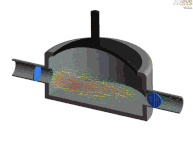Translations:Pumpen, Betriebs- und Regenwasserwerke/17/en: Unterschied zwischen den Versionen
| Zeile 1: | Zeile 1: | ||
==Diaphragm pumps for single-family house== | ==Diaphragm pumps for single-family house== | ||
[[File:193px-DiaphragmPump.gif|frame|link=https://commons.wikimedia.org/wiki/File:DiaphragmPump.gif#/media/File:DiaphragmPump.gif|Functioning of a diaphragm pump]] | [[File:193px-DiaphragmPump.gif|frame|link=https://commons.wikimedia.org/wiki/File:DiaphragmPump.gif#/media/File:DiaphragmPump.gif|Functioning of a diaphragm pump]] | ||
| − | Diaphragm pumps are an independent type of displacement pump, which are used in several fields, e.g. in family houses with small gardens. An elastic diaphragm is moved up and down by a piston. During the downward stroke the liquid is sucked through the inlet valve. During the upward stroke, the diaphragm presses the fluid out through the outlet valve from the pump head. The pumping cylinder is hermetically separated from the pump drive by the diaphragm. This means that diaphragm pump supplies uncontaminated fluid. Thus, all essential water fixtures can be sufficiently supplied in a single-family house by using very small pumps with very small flow rates. Due to the huge benefits in energy consumption and performance, suction characteristics and especially low noise level, these pumps are increasingly used in the single-family house applications, e.g. in the domestic water unit, RAINMASTER Eco. The optimum range of all fixtures in a single-family house falls very close to the pump characteristic curve. In contrast, for centrifugal pumps, which are currently used for rainwater harvesting, the usual operating points are very far from the characteristic curve (see diagram). This implies unnecessary power consumption in virtually all operating conditions of the centrifugal pump. The diaphragm pump, selected for rainwater harvesting or greywater recycling, ensures a maximum pressure of 3.5 bar and a maximum flow rate of 10 L / min. This is not only sufficient for most applications in a single-family house, but also offers an ideal performance range. For the most commonly used fixtures, e.g. toilet flushing, even 1 bar and 5 L / min is actually sufficient (see diagram). If several fixtures are simultaneously opened, then this results simply in a longer filling time for the fixture. | + | Diaphragm pumps are an independent type of displacement pump, which are used in several fields, e.g. in family houses with small gardens. An elastic diaphragm is moved up and down by a piston. During the downward stroke the liquid is sucked through the inlet valve. During the upward stroke, the diaphragm presses the fluid out through the outlet valve from the pump head. The pumping cylinder is hermetically separated from the pump drive by the diaphragm. This means that diaphragm pump supplies uncontaminated fluid. Thus, all essential water fixtures can be sufficiently supplied in a single-family house by using very small pumps with very small flow rates. Due to the huge benefits in energy consumption and performance, suction characteristics and especially low noise level, these pumps are increasingly used in the single-family house applications, e.g. in the domestic water unit, [https://www.intewa.de/en/products/rainmaster/rainmaster-eco/ RAINMASTER Eco]. The optimum range of all fixtures in a single-family house falls very close to the pump characteristic curve. In contrast, for centrifugal pumps, which are currently used for rainwater harvesting, the usual operating points are very far from the characteristic curve (see diagram). This implies unnecessary power consumption in virtually all operating conditions of the centrifugal pump. The diaphragm pump, selected for rainwater harvesting or greywater recycling, ensures a maximum pressure of 3.5 bar and a maximum flow rate of 10 L / min. This is not only sufficient for most applications in a single-family house, but also offers an ideal performance range. For the most commonly used fixtures, e.g. toilet flushing, even 1 bar and 5 L / min is actually sufficient (see diagram). If several fixtures are simultaneously opened, then this results simply in a longer filling time for the fixture. |
Aktuelle Version vom 8. November 2018, 12:51 Uhr
Diaphragm pumps for single-family house
Diaphragm pumps are an independent type of displacement pump, which are used in several fields, e.g. in family houses with small gardens. An elastic diaphragm is moved up and down by a piston. During the downward stroke the liquid is sucked through the inlet valve. During the upward stroke, the diaphragm presses the fluid out through the outlet valve from the pump head. The pumping cylinder is hermetically separated from the pump drive by the diaphragm. This means that diaphragm pump supplies uncontaminated fluid. Thus, all essential water fixtures can be sufficiently supplied in a single-family house by using very small pumps with very small flow rates. Due to the huge benefits in energy consumption and performance, suction characteristics and especially low noise level, these pumps are increasingly used in the single-family house applications, e.g. in the domestic water unit, RAINMASTER Eco. The optimum range of all fixtures in a single-family house falls very close to the pump characteristic curve. In contrast, for centrifugal pumps, which are currently used for rainwater harvesting, the usual operating points are very far from the characteristic curve (see diagram). This implies unnecessary power consumption in virtually all operating conditions of the centrifugal pump. The diaphragm pump, selected for rainwater harvesting or greywater recycling, ensures a maximum pressure of 3.5 bar and a maximum flow rate of 10 L / min. This is not only sufficient for most applications in a single-family house, but also offers an ideal performance range. For the most commonly used fixtures, e.g. toilet flushing, even 1 bar and 5 L / min is actually sufficient (see diagram). If several fixtures are simultaneously opened, then this results simply in a longer filling time for the fixture.
